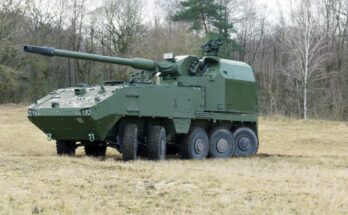by Nicholas Dawson, Forecast International.

The 2021 Dubai Airshow allowed many companies in the aerospace industry to spotlight their newest technology and advancements in the field of aerospace and defense. Countries and the commercial and defense industries use the event to sell their goods and make contracts for new imports and exports. Within this article, we will discuss several highlights of deals made within the defense industry as well as showcased products, with a focus on Russia, Israel, and the United Arab Emirates (UAE). These countries all had fruitful outings in the defense portion of the airshow.
Starting with Russia, Rosoboronexport CEO Alexander Mikheev and Rostec Corporation CEO Sergei Chemezov both stated that they had a very successful showing. Rosoboronexport reports that it exhibited a record number of products for the airshow, including aircraft, UAVs, missiles, and munitions. Mr. Mikheev stated that the airshow helped produce over $1.3 billion worth of contracts, which includes deals for combat aircraft, helicopters, drones, and engine supplies. The Rosoboronexport order book supposedly contains over two hundred helicopters from these contracts. Additionally, supply requests were worth over $2.5 billion, which includes munitions for various aircraft, helicopters, and drones.

Beginning with products Russia brought, the main attraction was the new light aircraft Su-75 Checkmate. The goal of the Checkmate is to make an affordable alternative to the F-35, J-31, F-Gripen, and J-10. Its primary role is as an aerial combatant with adaptions for ground attack, anti-ship, and reconnaissance. The Su-75 is viewed as an export-based fighter that that may prove attractive to countries such as the UAE, Vietnam, Pakistan, and India. The single-engine Su-75 features a “Matryoshka” automated logistics system (ALS) and will be able to carry the same munitions as the Su-35 and Su-57. The Matryoshka ALS is looking to rival the F-35 ALIS system with the hopes of also being labeled as a stealth aircraft. The Su-75 was designed by Sukhoi, a part of Rostec State Corporation UAC Holding Company, and it is looking to have a maximum load of 7.4 tons with a maximum takeoff weight of 18 tons and a 930-mile combat radius. Russian state media reports that Su-75 prototypes have begun production with the hopes that the first takeoff will take place sometime in 2023.
Along with the Su-75, Rosoboronexport displayed the generation 4++ Su-35 fighter. The Su-35 is a single-seat, twin-engine aircraft whose primary function is multirole fighter. It’s known as a highly maneuverable aircraft that can reach Mach 2.25, has a service ceiling of 18,000 meters, and a maximum payload of about 8.9 tons with a maximum takeoff weight of 38 tons. Current operators include Egypt and China. The Su-35 has seen success during the Syrian civil war.
Rosoboronexport also displayed several helicopters, including the Mi-28NE, Ka-52, Ka-226T, and Mi-17V-5. The Ka-52 and Mi-28NE are both attack helicopters, while the Ka-226T is a newly improved multimission helicopter that can be used for military and civilian missions. The Mi-17V-5 is a military transport helicopter that stems from the Mi-8/17 family of helicopters. One of the deals made in Dubai included supplying Bangladesh with two Mi-171A2 heavy helicopters for the Bangladeshi police. Along with the helicopters, Rosoboronexport also brought the Orion-10E and Orion-E UCAVs, with the Orion-E being the armed version of the Orion-10E, which has also seen success during the Syrian civil war and is in direct competition with U.S., Turkish, and Chinese drones. The Orion-E can carry a combat payload of 250 kilograms, and it has a flight altitude of 9,000 meters.
The UAE’s largest defense contractor, the EDGE Group, reported that it signed 13 agreements during the airshow. Along with these agreements, EDGE also signed 16 joint developments with several major industry players, including Boeing, Embraer, Raytheon, Lockheed Martin, Israel Aerospace Industries (IAI), and STRATA. An important deal was a new partnership between EDGE and the IAI to develop a new class of sea drones and a maintenance center for electro-optics technology. EDGE also garnered multiple contracts with the UAE Air Force and armed forces. These include servicing UAE aircraft with GAL, creating a new regional distribution hub for aircraft logistics with CATIC, teaming with EPI and STRATA to boost UAE aerostructures manufacturing capabilities, supplying the UAE armed forces with precision-guided missiles, and working with HALCON to introduce an advance weapon system on an A-29 Super Tucano.
UAE companies displayed a range of products. One of the more important attractions was the QX-5 and QX-6 UAVs. The QX-5 is an intelligence drone that performs well in reconnaissance and surveillance missions, with an extended range and better flight time than its predecessors. The QX-5 has a takeoff weight of 110 kilograms, a range of 100 kilograms, a carry payload of 25 kilograms, and a service ceiling of about 3,050 meters. The QX-6 is unique in that it has an autopilot and communication system to perform missions autonomously without the need for remote control. The QX-6 has a larger payload than the QX-5 because it is a cargo-based drone. The maximum payload is 150 kilograms, but it comes at the expense of endurance – a flight time of about four hours, compared to seven-plus hours for the QX-5. In addition to the QX series, the Reach-S drone was unveiled to the public. The Reach-S fixed-wing drone has a takeoff weight of 400 kilograms and can carry a payload of 120 kilograms. It has a service ceiling of 5,800 meters and a cruising speed of 80 knots. It can be used for both reconnaissance and transport missions. It can also be equipped with Desert Sting-16 precision-guided weapons and serve a combat role if needed.
Due to the Abraham Accords and the slow normalization of relations between Israel and their Gulf neighbors, Israel was able to bring its industries to the Dubai Airshow for the first time. At the event, Israeli Air Force officials and UAE officials discussed the possibility of conducting joint-training exercises. The countries have agreed to trade technologies with each other, and they are going to be working on a potential moon mission.
Several of Israel’s large companies made it to the event, with the IAI, Rafael, and Elbit Systems all making an appearance. The IAI was able to sign agreements with various local companies and improve existing partnerships. Rafael presented its MIC4AD command and control system, a provider for multiple systems, multilayer, and multirange air and missile defense threats. The MIC4AD can be used domestically, nationally, or regionally and allows for an improved radar and IFF system that can be connected to the Air Traffic Control Picture and Mission Planning system. Rafael mentioned it can work with SPYDER, David’s Sling, Iron Dome, and/or other operational defense systems. The MIC4AD system is already deployed by 28 air forces. Rafael also brought the SPYDER, a surface-to-air missile system to counter aircraft, helicopters, UAVs, and other missile attacks. Additionally, Rafael launched a joint venture with G42, an artificial intelligence and cloud company based in Abu Dhabi.
Elbit Systems announced that it will create a new UAE-based subsidiary called Elbit Systems Emirates (ESE). Elbit Systems also brought the E-LynX radio system, the HattoriX fire support system, the Rampage long-range air-to-ground precision strike missile, and the SkyStriker UCAV. The SkyStriker is a loitering munition that is used for long-range precision strikes. One of its main appeals is that it is a fully autonomous UAS that can strike operator-designated targets with a 5-kilogram warhead. Better known as a suicide drone, it has seen success in Azerbaijan during the previous Nagorno-Karabakh war against Armenia.
These are only some of the major deals and goods displayed at the Dubai Airshow 2021. Saudi Arabia made several significant deals in the commercial airline sector. Overall, the airshow produced over $78 billion worth of commercial and defense contracts signed within the event’s five days. The ongoing success of this airshow, especially after the COVID-19 pandemic, shows that we are slowly returning to some form of normalcy. Hopefully, the next exhibitions will have similar success so that our technology and relations can improve worldwide.
For 50 years, Forecast International intelligence reports have been the aerospace and defense industry standard for accurate research, analysis, and projections. Our experienced analysts compile, evaluate, and present accurate data for decision makers. FI's market research reports offer concise analysis of individual programs and identify market opportunities. Each report includes a program overview, detailed statistics, recent developments and a competitive analysis, culminating in production forecasts spanning 10 or 15 years. Let our market intelligence reports be a key part of reducing uncertainties and mastering your specific market and its growth potential. Find out more at www.forecastinternational.com




